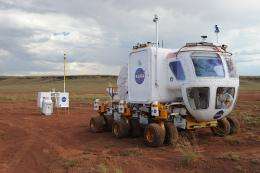Students To Participate In NASA's Lunar Field Test Activities

(PhysOrg.com) -- To prepare for human exploration of the moon and other destinations in our solar system, NASA is conducting a field test of rovers and equipment at an Earthly site in the Arizona desert. Hundreds of students are invited to experience it.
NASA's annual Desert RATS -- or Research and Technology Studies -- field test is underway. The agency has planned a variety of activities to engage students in the practical application of the science, technology, math and engineering skills critical to space exploration.
Dozens of students from Flagstaff and surrounding areas have been invited to visit the test site at Black Point Lava Flow on Sept. 16. They will be introduced to the work NASA engineers and researchers conducted during the field test. In addition, college teams that ranked highest in NASA's 2009 Moon Work Engineering Contest will present their projects to members of the NASA field test team. The winning teams are from the University of Maryland, College Park; the University of Akron, Ohio; and Texas A&M University, College Station.
As part of the day's activities, hundreds of elementary and middle school students participating in "Education Alley" at the American Institute of Aeronautics and Astronautics' Space 2009 Conference in Pasadena, Calif., will observe field test activities and chat live with the NASA engineers and researchers via satellite at 1 p.m. EDT. Heather Paul and Kimberly Land of NASA's Exploration Technology Development Program will host the event, which will include NASA experts explaining how the agency plans to use similar rovers on the moon; video clips of field test demonstrations; and questions from students. Students everywhere can view the event and learn more about the Desert RATS activities at: www.nasa.gov/exploration/analogs .
The 2009 Desert RATS tests focus on a simulated 14-day mission. Two crew members -- an astronaut and a geologist -- will live for 14 days inside NASA's prototype Lunar Electric Rover, searching the area for features of geologic interest and conducting simulated moonwalks to collect samples. NASA's K10 scout robot examined the location in August to identify areas of interest. NASA's heavy-lift rover Tri-ATHLETE -- or All-Terrain Hex-Limbed Extra-Terrestrial Explorer -- will carry a habitat mockup to which the rover will dock.
The Desert RATS tests have taken place for more than a decade, as engineers from NASA centers have worked together with representatives from both industry and academia to determine what will be needed when NASA makes trips to other worlds. Future Desert RATS analog test activities could involve international partners in the quest toward human planetary exploration. This year's work will build on the investigations of previous years, increasing the scope and length of the tests.
NASA centers involved are Johnson Space Center in Houston; Langley Research Center, in Hampton, Va.; Jet Propulsion Laboratory in Pasadena, Calif.; Ames Research Center in Moffett Field, Calif.; Kennedy Space Center in Florida.; Goddard Space Flight Center in Greenbelt, Md.; Glenn Research Center in Cleveland; Marshall Space Flight Center in Huntsville, Ala.; and NASA Headquarters in Washington.
Desert RATS participants from outside of NASA include the Smithsonian Institution in Washington; the United States Geological Survey in Flagstaff, Ariz.; Arizona State University in Tempe; University of Texas at El Paso; University of Colorado at Denver; Brown University in Providence, R.I.; and the Mars Institute at Moffett Field, Calif.
For more information about NASA's "Moon Work" contest, visit: moontasks.larc.nasa.gov
Provided by JPL/NASA (news : web)

















